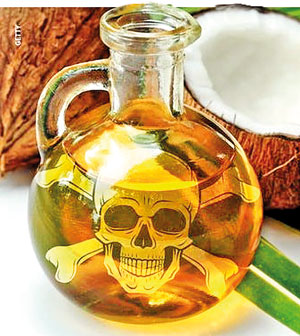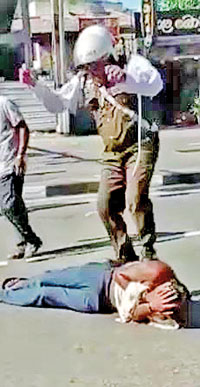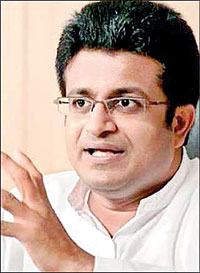Columns
After the sugar scam, now toxic-hit coconut oil scare
View(s):
HEALTH HAZARD: The stables may have been bolted but have the horses slipped out
Even before the 16 billion buck sugar scam had melted on the public tongue, the spectre of a horrific health scare has now risen to envelop the people’s wellbeing in a toxic shroud.
The sugar scam had blown a gaping hole in the public coffers, skimming an estimated Rs. 16 billion from the Treasury vaults. The scam had been confirmed officially when the Finance Ministry report to Parliament last month blew the lid on what may become the financial fiddle of the decade, and exposed that, in spite of the Government slashing the duty on sugar imports by Rs. 50 to 25 cents, the people had not benefitted nor had the Government gained, incurring, instead, a massive loss of Rs. 16 billion.
But no credible explanation has been offered to clarify the amazing co-incidence in timing between the date of tax and release of sugar to the market that made rich pickings possible nor has an official investigation of possible insider dealings still been launched to hold accountable those who had siphoned off the missing sugar billions and padded their pockets with this flash flood of manna from heaven by diverting the tide for their personal unjust enrichment.
But while the mystery of the missing billions still continues to elude unravelment, a horrifying threat to the people’s health has arrived at the nation’s door step with worrying reports suggesting it might have spread to the interior and invaded the people’s kitchenettes.
On arrival at the port, customs suspected that the 184,000 kilo coconut consignment imported by four regular oil importers may have been contaminated with a cancer causing substance known as aflatoxins, a family of toxins produced by certain fungi found on agricultural crops abundant in warm and humid regions.
Two tests, one by the Health Ministry’s Food Safety Unit and the other by the Sri Lanka Standards Institute, confirmed the suspicions. SLSI Director General Dr. Siddhika Senaratne revealed that aflatoxin carcinogens found in the test samples were three times more than the set standard of 10 micrograms per kilogram.
The red flag was raised on March 23 by the All Ceylon Traditional Coconut Oil Producers’ Association during a press conference where they claimed that 13 containers of the contaminated coconut oil had furtively entered the market. ACTCOMA (All Ceylon Traditional Coconut Oil Manufacturers’ Association) Convener Buddhika de Silva also said Aflatoxin, a carcinogen, is especially prevalent in unrefined palm oil and substitute oils that have been imported.
 But while a ministerial effort was made to refute the claim the oil had seeped into the market, stating the entire cargo was safe in Custom custody at Custom warehouses, the Custom Chief revealed that the oil consignment had been released to the importers’ own warehouses since the Custom warehouses did not have the capacity to store all the imports to the country.
But while a ministerial effort was made to refute the claim the oil had seeped into the market, stating the entire cargo was safe in Custom custody at Custom warehouses, the Custom Chief revealed that the oil consignment had been released to the importers’ own warehouses since the Custom warehouses did not have the capacity to store all the imports to the country.
Now the detection and seizure on Tuesday of two oil bowsers in Dankotuwa and a further two on Thursday night near the Dambulla Economic Centre carrying 20,000 kilos of possibly contaminated coconut oil have put paid to government claims that the situation is well under control with the toxic oil safely under seal in importers’ own warehouses, and refuelled fears that the condemned oil may have entered and flooded the market nonetheless.
In the midst of conflicting ministerial and official reports, what the continuing drama has so far starkly revealed is the gross lack of safety standards: an iron clad system to guarantee that food unfit for human consumption is prevented entry to the local market.
Even whilst the masses ponder on the cheerless prospect of celebrating their Sinhala Aluth Anuruddha with kavun and kokis deep fried in toxic oil, it behoves the Government to order a comprehensive study to the existing procedures and mechanisms that presently regulate food imports and its release to the market; and rectify soonest the massive shortcomings and firmly close the yawning loopholes the present crisis has shockingly exposed.
Or else, in the manner the bond scam had shadowed the Yahapalana Government to an early grave; and the way the unsolved sugar swindle is destined to stalk the present regime for the rest of its mandated tenure, imperiling the nation’s health by allowing free rein for toxic cancer causing food to enter the unsuspecting masses’ market, will make the tolling bells knell the last dirge.
 THE HIGH JUMP Cop’s ‘double foot stomp’ lands him flat out on mat Laws soon to have magisterial eye on police stations A traffic cop who executed wrestling’s double foot stomp’ on a fallen lorry driver nabbed for negligent driving on Monday was arrested and remanded till tomorrow. Television viewers saw the shocking scenes where the unresisting lorry driver was first brought to the ground with a classic wrestling tackle, followed by the cop leaping to the air to jump on the hapless victim and land on his abdomen with the full force of his body weight. Evidently, the wrestling buff hadn’t quite mastered the difficult move for he lost his balance the moment his boots made contact and tripped unceremoniously to the ground. As public protests soared at this blatant battery on an unarmed, unresisting citizen on a busy public highway in broad daylight in Pannipitiya, it took Police Spokesman DIG Ajith Rohana to sooth the disquiet.  The landing In a televised message, he declared: ‘The incident is one where a lorry driver driving negligently had hit the OIC of the Maharagama Police Traffic Division, injuring him. The policeman in question, who is also attached to the same division, had then proceeded to assault the lorry driver in a most condemnable manner. These things normally happen in villages where the vehicle is burnt and the driver is beaten by the crowd in the heat of the moment. But a police officer has no right whatsoever to behave in this manner. We do not condone in any manner this action. If the person was resisting arrest the police officer could have used reasonable force to apprehend him under the law. We categorically state that the Sri Lankan Police condemn this despicable act. Since then, the police officer has been arrested; he has been interdicted and his work stopped and he will be produced in court.’ In another interview DIG Ajith Rohana said, ‘if a person had resisted arrest or was trying to abscond, the policeman could have used reasonable force but to jump on the person, stand on his stomach and beat him. This was totally unacceptable to the professional code of the Sri Lanka Police.’ Ajith Rohana further told the interviewer that if an unarmed person, who is not resisting a legal order of even a uniformed police officer and shows no sign of posing a threat to the policeman, is subjected to illegal assault then that person can avail himself of the right to self-defence to escape injury. That’s welcome news — to know that the Lankan police top brass accepts the notion that a right to self-defence to a charge of obstructing a policeman in the course of his duties exists in the statute books but, of course, common sense dictates that, in a realistic world, the right should be exercised only as a last resort and at one’s own peril.  THE TUMBLE A series of police brutality incidents at police stations have been reported recently to taint the honour of the Sam Browne belt; and the human rights issue this entails, has, perhaps, forced the Government to act. On March 24, the day following the Geneva sessions at which the resolution, warning the Lankan Government to arrest the tide of the deteriorating state of human rights in Lanka, had been successfully adopted, Justice Minister Ali Sabry presented to Parliament amendments to the Code of Criminal Procedure to further strengthen and protect the rights of those held in custody. The welcome bill when enacted will impose a duty on each and every magistrate to visit every police station situated within the judicial division in respect of which he is appointed, at least once in every month to ensure the welfare of those held in custody. The magistrate’s duty will be to personally see the suspects and inquire into his wellbeing, welfare and the conditions under which they are held at the police stations. He must record any complaints they make, and note his own observations, too. If he is of the opinion that a suspect has been subjected to any form of cruelty or torture – as defined in the Convention against Torture and other Cruel, Inhuman or Degrading Treatment or Punishment Act – he may direct the suspect to a Judicial Medical Officer for a medical examination. On the report received, the magistrate may then order treatment and for change of custody. The amendments are indeed welcome. It will contribute to the government’s efforts to clear up its shoddy act on human rights and cleanse Lanka’s image in international eyes. Hopefully, the amended Act will also specify that magisterial visits to police stations shall be unannounced and random and not by prior appointment on a fixed date. Hopefully, it will also ease the fears that suspects in police custody will, away from public sight, not be subjected to the treatment witnessed in broad daylight in Pannipitiya this week: Fears that the ‘innocent until proven guilty’ citizens will not be used as punching bags in interrogation chambers for sadistic coppers to hone their wrestling or angampora prowess.
| |
 GAMMANPILA: Gimmick king Gamman’s record: To what greasy heights descendedWhen news spread that Lanka’s Energy Minister Udaya Gammanpila has revealed on his Facebook account that he had set a new world record as Lanka’s Energy Chief, many couldn’t resist the temptation to sneak a peek into his online chronicle and discover to what new heights the much bragging Gammanpila had scaled for his country’s glory and benefit. But, alas, it fell a trifle short of the most that could be expected even of him. Suffice to say, the total sum of his record achievement was nothing more than to have climbed down a Ceylon Petroleum Corporation oil tank and trumpeted, from the greasy dregs of its nadir, he had become Lanka’s first Minister of Energy to have accomplished the staining feat. How proud his fellow Cabinet members must be of him, how secretly envious they must be of his great achievement? Not that they haven’t tried, of course, to break new ground in the provinces of their own portfolios. To recall a few, there was the hair raising climb of the Coconut Minister up a coconut tree to hold a press conference atop; the stomach churning scene of a former Fisheries Minister eating a whole fish raw on television; the eyebrow raising event when the Industries Minister pulling a fag to boost a local cigarette industry against anti-smoking regulations, the worrying moment of the present Health Minister turning herself to a laboratory mouse and gulping down an untried dubious concoction to test it for efficacy to cure and prevent COVID. Compared to these, the Energy Minister’s unimaginative feat of merely climbing down an oil tank fizzles out as a nonstarter. Now had the oil tank been sealed after Gammanpila’s descent, and had he been left there to successfully make his great escape, Houdini style, that would have left him with much to trumpet from the turrets and much to talk about for the world. WARNING: These stunts should not be attempted by anyone except by professionals and that, too, only under psychiatric supervision. |



Leave a Reply
Post Comment